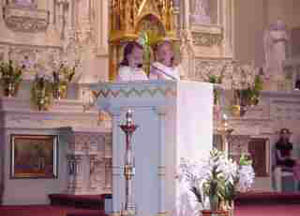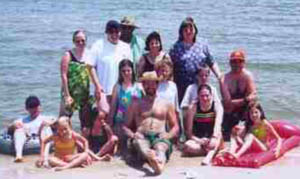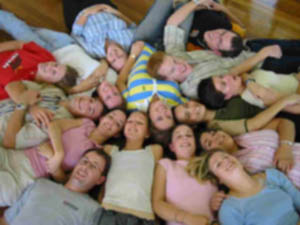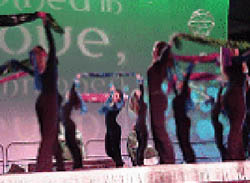 |
Traditionalist Issues
The Crisis in Catholic Education
and St. Thomas’ Solution
Kathleen Willett Redle, M.F.A.
Just what has happened to the Catholic Education system and why are we getting such bad catechesis? Why is there so much bad theology and liberalism rampant at Catholic Schools and Colleges?
Before I begin to present reasons, I will provide an illustration from personal experience. I want to “tell my story” – as the liberals say in their conferences – in order to expose the progressivists at their own game.

A new catechesis ...
Above, kindergarteners at Holy Angels Catholic School prepare a liturgical service as a class project for Thanksgiving (2002).
Below, a group from the St. Luke Youth Ministry "discover themselves and the church" at a beach retreat


Above, young men and women from an archdiocesan youth ministry team sprawl together on the floor for a group picture.
There are no longer rules of modesty. Youth of both sexes can touch each other without any censure from the religious authority.
Below, another novel means of youth ministry - dancers in black body suits perform at Cardinal Mahony's youth conference

Internet pictures |
My story I guess is very similar to that of so many others from my baby-boomer post Vatican II generation. I grew up in Middle America in the Cleveland Diocese and attended Holy Family Catholic grade school in Stow, Ohio. My parents grew up during the depression and lived through WWII and the Korean War. They knew what it was like to sacrifice and live through hardships – not like so many of my generation who had things very easy comparatively. My baby-boomer generation had to deal with a far more insidious kind of battle – the cultural and sexual revolution of the 60's that devastated so many lives and the aftermath of the Vatican II “spirit” in Catholic education.
I had many good experiences at Holy Family School, but the post Vatican II revolution hit my school rather hard. In 1967 when I started first grade there were several nuns in the school, but by the time I was in third grade the Convent of sisters was almost cleaned out. The principal, who was a nun, ran off with a Jesuit priest from a nearby Walsh Jesuit house. Over a period of some 40 years starting in the late 1950s, our parish had allegedly 4-5 pedophile priests.
We had one “old guard” pastor who served from July 21, 1955 to December 1977, Fr. John H Archibald, a priest who was not a pedophile and wore a cassock and biretta. He apparently had the task of helping troubled priests. Some time before WWII, Fr. Archibald was educated at Louvain Seminary (known to be a progressivist seminary even in his day) (1) and he was a progressive priest despite some of his traditional habits. He built one of the first Churches-in-the-round in the U.S. Fr. Archibald permitted the most modern liturgical experiments in our parish school, such as clown Masses, guitar Masses (“Kumbaya” was popular), liturgical dance, students around the altar at Mass and encounter groups in the school. Our Religion classes consisted of listening to the rock opera’s Godspell and Jesus Christ Superstar; we also saw the movie versions. Some of the students who saw it told me the movie showed that Mary Magdalene was the girlfriend of Jesus, similar to the Da Vinci Code’s antichristian blasphemous propaganda so popular today.
Well like so many parents from that era, mine thought that their children were getting a Catholic education. They knew about some of the novelties but they were taught that you must trust and obey, and not question the Church or priests. Under normal circumstances when Churchmen were doing what they were supposed to do, this was OK. But after Vatican II the push to liberalize and supposedly “reform” the Church and bring it back to a more “primitive” early stage caused a great deal of damage, and not complaining was not the best policy for parents. Somehow I don’t quite think that the early Christians did clown Masses. Moreover, we were not taught from the Baltimore Catechism but from the most up-to-date liberal Catechisms that were light on doctrine and heavy on the latest theological fads.
Along with this damage to our school came the doing away with customs, so off came the nun’s habits, and often times we saw the priests in shorts and shirts without Roman collars. We were supposed to call them Fr. Bob or Fr. Russ. The nuns with knee-length dresses who had formerly worn habits were now teaching us sex ed. Familiarity breads contempt, but not in the New Church.
At least at that time they were not taking us to local “health clinics” or telling us about the birds and the bees in mixed company. Today this sex ed has become so bad I had to pull my children out of a Catholic school and home school them because they were taken to a local “health clinic” and a nurse presented “condom education” to them. If that wasn’t bad enough, my son’s religion teacher told him that Jesus was not “eating himself during the last supper ” and that the Eucharist is “just a symbol.” Many Catholics are turning to the New Age movement or Protestantism because of the poor Catholic religious education they receive in Catholic grade schools and high schools.
I am sure that many of my readers can relate to these stories and many may even have a few worse ones that come to mind. But the real question we have to ask ourselves is this: What saved our parents’ and grandparents’ generations from this kind of perverse so-called Catholic education and how can we restore it?
Scholastic Philosophy: Safeguard of Doctrine
Catholic parents should read Pope Pius XI encyclical on Catholic Education Divini Illius Magistri (31/12/1939) (click here) for a start if they want to understand how to educate their children in the faith.

The Triumph of St. Thomas Aquinas. His scholastic method reigned in the Church until Vatican II |
The system of thought which insulated seminaries and Catholic Colleges from the insidious heresy of Modernism – which Pope St. Pius X termed the “syntheses of all heresies” –was Scholasticism, which the pre-Vatican II Popes said should be taught in the seminaries to stop the proliferation of heresy.
The rejection of Scholastic language in the formulation of Vatican II documents, the ambiguous language used in such texts, and the fact that no mention at all was made of the importance of Scholastic theology caused a crisis in Catholic education. A void was created which was filled by “progressive” and revolutionary secular philosophies such as Existentialism, Phenomenology, Hegelian dialectics, and Marxism. Scholasticism was a philosophic and theological system based on the reconciling of Aristotelian philosophy and Christianity by the great Dominican priest and theologian St. Thomas Aquinas.
The rejection of the Scholastic method– a system based on Aristotelian metaphysics (although pagan, it followed the immutable truths of natural reason) – was a progressivist ploy to rid Western thought of immutable truths that can be known through the use of reason and reject the tenets of moral absolutes in Christian Civilization, and also the principle of non-contradiction.
With this came the progressive recognition of Eastern religion and thought, which denied immutable truth and reality in favor of Buddhist and Hindu thought. If everything is just an illusion as Buddhism implies, then why bother being a moral person? Our Catholic textbooks are riddled with this Eastern thinking. This resulted in the enthronement of moral ambiguity and Situation Ethics as promoted by such Vatican II theologians as Hans Küng, whose progressivist theology is essentially relativistic and produces havoc on Catholic education.
As the infamous ex-Canon Abbé Roca (1830-1884), an apostate priest and Satanist, taught:
"The new church, which might not be able to retain anything of Scholastic doctrine and the original form of the former Church, will nevertheless receive consecration and canonical jurisdiction from Rome" (Glorieux Centenair, 1889).
He continued:
“St. Thomas himself, should he come back to life ‘would hasten to consign his Summa Theologica to the fire and to replace it with a Summa Scientifica’" (Ibid.).
During Vatican II the progressive periti were successful in employing a “pastoral language” in place of the precise Scholastic method that left no “wiggle room” for ambiguous language or heterodox interpretation of Church documents.
Johannes Dörmann posited the following about Vatican II:
"The chief theologians [who were actually directing the Council] saw very clearly that in this question of Scholastic language, both theology as well as the Faith itself were at stake. For Scholastic terminology was indissolubly linked to Scholastic Philosophy which itself is linked to Scholastic Theology which is, in its turn, closely knit to the Dogmatic Tradition of the Church.” (The Strange Theology of John Paul II and the Spirit of Assisi, vol. 1, Kansas City, MO: Angelus Press, 1994, p. 52.)
Consequently, this abandoning of Scholastic language would be devastating for the time-honored perennial doctrines and teaching of Apostolic Tradition as handed on to Catholics and their children.
Dörmann continued:
"This rejection or abandonment of the 'language of the Scholastic school' by the Council Fathers constituted for them [those theologians directing the Council] the sine qua non or indispensable condition which would assure a complete rupture from traditional dogmatic teachings, in order to set the 'New Theology' [whose proponents were Bloisey, De Lubac and Teilhard] in place after having ceased using 'the previous traditional theology' and discarding it once and for all (ibid., p.53)"
We must return to the time honored and orthodox method used in the Latin Rite of the Church, that of the Scholastic method, if we are going to protect our children from heresy. We must stop the use of religious syncretism in Catholic Catechesis and return to the Scholastic method. The attack on the Scholastic method by the enemies within the Church did not just happen recently. The liberals and modernists were assailing it in the 19th century and in the beginning of the 20th century. It was because of it that Pope Pius IX included a warning in his Syllabus of Errors, stating it was false to claim that "the method and principles of the ancient Scholastic doctors were not suited to the needs of our times and the progress of science.” (2)
So get yourself a copy of a St. Thomas Aquinas Catechism and you will learn the beauty of this great Doctor of the Church’s teaching and why it has been a staple for the Church for hundreds of years. Share his ideas with your children at the dinner table.
St. Pius X exposes modernist aims to destroy the Scholastic method

St. Pius X foresaw the Modernist attack on Scholasticism |
St. Pius X demonstrated the disdain that modernists have for the Scholastic method in "On Modernism":
"They wish the scholastic philosophy to be relegated to the history of philosophy and to be classed among absolute systems, and the young men to be taught modern philosophy which alone is true and suited to the times in which we live. They desire the reform of theology: rational theology is to have modern philosophy for its foundation, and positive theology is to be founded on the history of dogma. As for history, it must be written and taught only according to their methods and modern principles. Dogmas and their evolution, they affirm, are to be harmonized with science and history. In the Catechism no dogmas are to be inserted except those that have been reformed and are within the capacity of the people.
“Regarding worship, they say, the number of external devotions is to he reduced, and steps must be taken to prevent their further increase, though, indeed, some of the admirers of symbolism are disposed to be more indulgent on this head. They cry out that ecclesiastical government requires to be reformed in all its branches, but especially in its disciplinary and dogmatic departments. They insist that both outwardly and inwardly it must be brought into harmony with the modern conscience which now wholly tends towards democracy” (sec. 38).
St. Pius X unmasked the disdain of the modernist towards Scholasticism:
“If we pass on from the moral to the intellectual causes of Modernism, the first and the chief which presents itself is ignorance. Yes, these very Modernists who seek to be esteemed as Doctors of the Church, who speak so loftily of modern philosophy and show such contempt for scholasticism, have embraced the one with all its false glamour, precisely because their ignorance of the other has left them without the means of being able to recognize confusion of thought and to refute sophistry. Their whole system, containing as it does errors so many and so great, has been born of the union between faith and false philosophy” (sec. 41).
St. Pius X gave us the antidote to bolster Catholic education by combating the glamour and sophistry of modernist thinking:
"Anyone who in any way is found to be tainted with Modernism is to be excluded without compunction from these offices, whether of government or of teaching, and those who already occupy them are to be removed. The same policy is to be adopted towards those who openly or secretly lend countenance to Modernism either by extolling the Modernists and excusing their culpable conduct, or by carping at Scholasticism, and the Fathers, and the magisterium of the Church, or by refusing obedience to ecclesiastical authority in any of its depositories; and towards those who show a love of novelty in history, archaeology, biblical exegesis; and finally towards those who neglect the sacred sciences or appear to prefer to them the secular."
"In the first place, with regard to studies, We will and strictly ordain that scholastic philosophy be made the basis of the sacred sciences” (sec. 45).
It is time to return to Scholastic teachings
The confusion and lack of sound Catechetical teaching in our Catholic education today is due directly to what Pope Pius XII declared over 50 years ago:
“Unfortunately, these advocates of novelty easily pass from despising Scholastic theology to the neglect of and even contempt for the teaching authority of the Church itself, which gives such authoritative approval to Scholastic theology. This Teaching Authority is represented by them as a hindrance to progress and an obstacle in the way of science” (Humani generis, sec. 18).
It is time for the Catholic Bishops of America and all over the world to stop the novelties and syncretism in Catholic education (3) and bring back the solid Scholastic teaching which is a bulwark against heresy and hetero-praxis. They must act like Shepherds and protect their flocks from the rampant apostasy we are witnessing in our post Vatican II Catholic educational system.

Footnotes
(1) Archbishop Jean Jadot, b. 1909, Pope Paul VI's Apostolic Delegate to the United States from 1973 1980, was a progressivist who studied at Louvain and turned out most notorious picks, such as Bishop Walter Sullivan of Richmond, VA., Archbishop Rembert Weakland of Milwaukee, and Roger Cardinal Mahony of Los Angeles, who also studied at Louvain.
Paul Likoudis tells us: “Other men who became Bishops during Jadot's tenure included Rochester Bishop Matthew Clark; Albany's Howard Hubbard; former Santa Fe Archbishop Roberto Sanchez, who resigned in a sex scandal; former San Jose Bishop Pierre DuMaine; former Honolulu Bishop Joseph Ferrario; San Antonio Archbishop Patrick Flores; former Newark Archbishop Peter Gerety; Joliet, IL, Bishop Joseph Imesch; Louisille Archbishop Thomas C. Kelly, O.P., a former staffer at the Apostolic Nuncio under Jadot; Bernard Cardinal Law of Boston (whom Jadot selected as Bishop for Springfield Cape Girardeau, MO), Cincinnati Archbishop Daniel Pilarczyk; Saginaw, Mich., Bishop Kenneth Untener – to name a few more – all of whom, supposedly, mirrored his own progressive image as a ‘man of the people’” (“Still Proud of Bishops He Gave Us,” The Wanderer, September 26, 2002).
It is important to note that some of these Bishops were reported to be active homosexuals. Some, such as Weakland, have admitted to being homosexual, and others support homosexuals.
See also, “From Greatness to Decadence The Catholic University of Louvain” by Alice von Hildebrand; and Goodbye, Good Men by Michael S. Rose, (Cincinnati: Aquinas Publishing, Ltd., 2002), pp. 73 8.
There is definitely a connection between perverse/unorthodox catechesis and perverse clerics and religious. As I noted, Holy Family Church in Stow was reputed to have four or five pedophile priests in a 40-year period, which is a very high number to have in one parish. I do not wish to imply that Fr. Archibald was a homosexual or promoted it, but some of the priests accused of improprieties with minors were under him during his tenure as pastor: Joseph Seminatore, 1970-1973, exonerated; Fr. Russell Banner, I975-mid 1979; Fr. J. William Mcool, mid 1973 to mid 1979; Fr. Joseph Libreth, mid 1992-2001 (there after Fr. Archibald left); the late Father J. Leo Brennan, 1954–1955, who abused several children at Holy Family (before Fr. Archibald was pastor).
Fr. Archibald allowed Banner and Mcool to introduce radical liturgical practices such as the ones I mentioned. Louvain also turned out Archbishop Fulton Sheen, but this does not change the fact that many progressivist clerics taught or had association with Louvain, as Likoudis points out:
“During the 1960s, Jadot was a cheerleader in Belgium for a number of his friends from Louvain University who helped run Vatican II. One was Dom Lambert Beauduin, the Benedictine from Chevetogne who, in 1945, planted the idea in the mind of a papal diplomat in Paris named Angelo Roncalli that the Church needed a council” (Likoudis, “Still Proud of Bishops,” ibid.)
Progressivism in Louvain University started long before Vatican II. Michel Kesteman opines:
“About ecumenism, not wanting to help to re-launch Thomist thinking, Cardinal Mercier opened the ‘Conversations of Malines’ with the Anglicans [early interfaith conference in 1926]. Dom Lambert Beauduin created the priory of Amay and Chèvetogne to contribute to the encounter among Christians: John XXIII did not forget this encounter, and Cardinal Suenens continued on the same path.”
“About exegesis , the school of Louvain allowed the development of Biblical and Patristic Studies that nourished the theologians of Vatican II and formed the generations of biblical scholars, among whom we can name Msgr. Cerfaux, Frans Neirynck, and Jacques Dupont.” “Under the Sign of Noah,” Fatima, Brussels: 2004).
No doubt Fr. Archibald, who was an expert in music, came under the influence of Dom Beauduin (an avowed ecumenist) who shared many of his same interests.
(2) Fr. Jean Marie Charles- Roux (Mel Gibson’s priest on the set of the “Passion” movie), age 90, speaking about Adam and the first sin in the garden, said this:
“He [Adam] used his God-given ability to choose, and chose according to his inclination, against the command of God, which had been made clear to him. And so has the whole of so-called Western civilization since the War of Independence of the United States and the French Revolution. For, since then, all the principles of life in our society aim to serve man as he conceives his good without any concern for God. ‘Democracy,’ ‘Liberalism,’ ‘Rights of Man’ are the political, social, and temporal form of ‘Original Sin.’ For having condemned them in the Syllabus of Errors, Pius IX is about to be proclaimed a Doctor of the Church.”(Inside the Vatican, September 2004).
(3) E.g., the “Sikh Day” at Holy Rood Catholic Primary School in Barnsley, South Yorkshire (“Why are they teaching are Catholic Children about a false religion when they do not even know basic Catholic doctrine?” Internet site).
Regarding post secondary education, see the story about the professor of theology and former priest (as of 1975) Paul Knitter at Xavier University (Cincinnati, OH), a religious syncretist who teaches his students about Eastern Religion and twists Catholic theology: "Theology of Dr. Paul F. Knitter” by Michael Rose, Internet site.
Knitter signed an ad that said: "We call upon the Church to discard the medieval discipline of mandatory priestly celibacy, and to open the priesthood to women and married men, including resigned priests, so that the Eucharist may continue to be the center of the spiritual life of all Catholics” (ibid.).
Posted November 10, 2004

Related Article
 The Da Vinci Code: Blasphemous Thesis and Bad History The Da Vinci Code: Blasphemous Thesis and Bad History

|
Traditionalism | Hot Topics | Home | Books | CDs | Search | Contact Us | Donate

© 2002- Tradition in Action, Inc. All Rights Reserved
|
 |
|